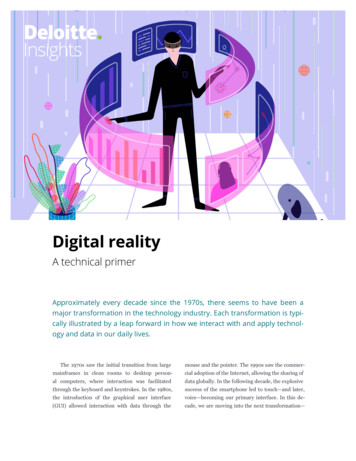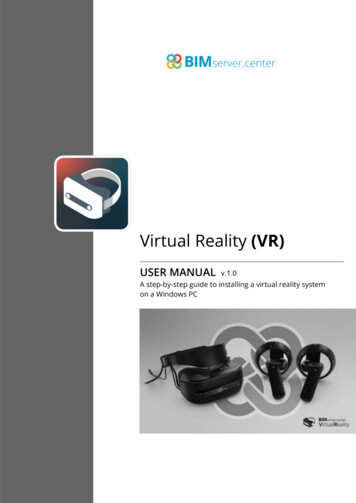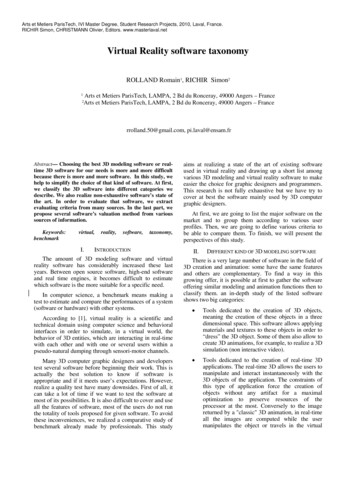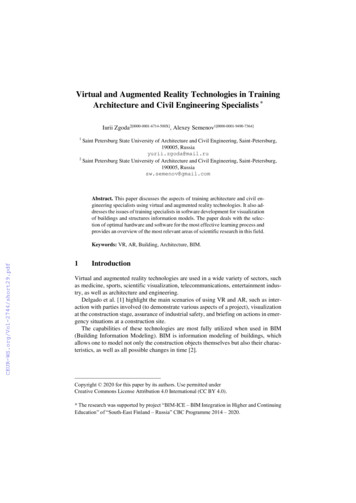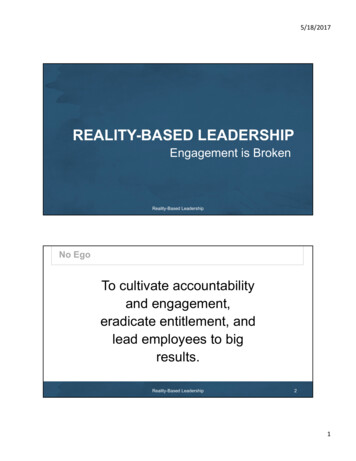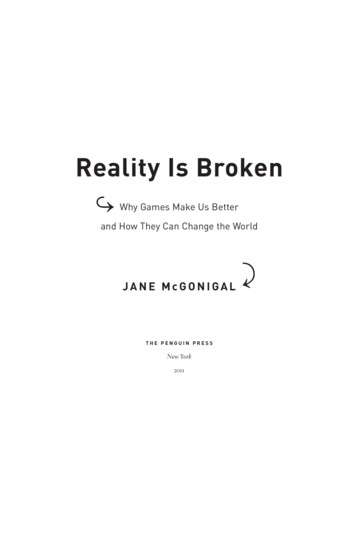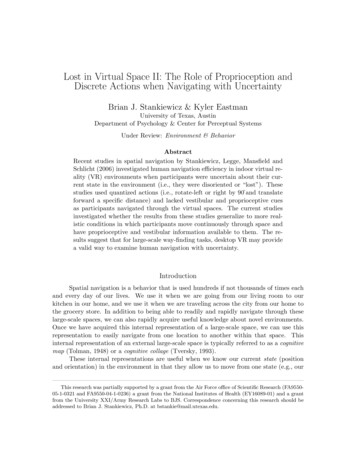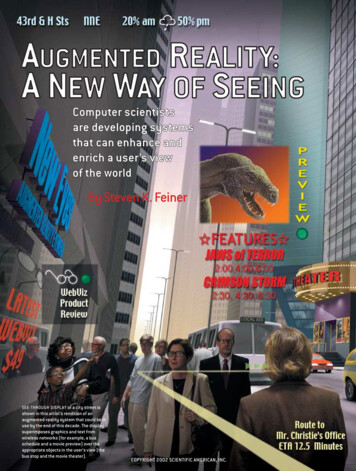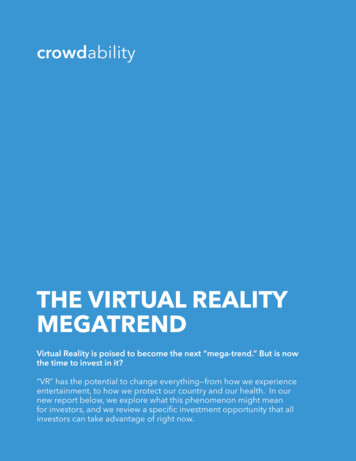
Transcription
crowdabilityTHE VIRTUAL REALITYMEGATRENDVirtual Reality is poised to become the next “mega-trend.” But is nowthe time to invest in it?“VR” has the potential to change everything—from how we experienceentertainment, to how we protect our country and our health. In ournew report below, we explore what this phenomenon might meanfor investors, and we review a specific investment opportunity that allinvestors can take advantage of right now.
OUR NATIONAL DEFENSEAfter a high-profile security breach at theWhite House last year, Secret Service DirectorJoseph Clancy stood before Congress andmade an impassioned request:To make sure that his team was adequatelyprepared to protect the President, he neededmillions of dollars to build a full-scale replicaof 1600 Pennsylvania Avenue.As Clancy explained:Right now, we train on a parking lot. Wedon’t have the bushes, we don’t have thefountains, we don’t get a realistic look at theWhite House. There are no structures, vehiclegates, lighting or other aids to enhance thetraining simulations It’s important to have atrue replica of the White House so we can doa better job The technical term for what Clancy sought tobuild is a “MOUT,” which stands for “MilitaryOperation in Urban Terrain.”Clancy also requested funding for severalother MOUTs, including a “live-fire shoothouse” and a “tactical village” that wouldreplicate typical city streets.These requests reflect a new reality: we livein a world filled with terrorists, a world whereevery arm of our military needs to preparefor nearly unthinkable scenarios. As highstakes missions like the Bin Laden raid haveproven (more on that later), when failure isnot an option, it’s highly-trained people—notmachines or drones—who are sent in to getthe job done.EARLY-STAGE PLAYBOOKThe Virtual Reality IndustyAt-a-GlanceVirtual reality first appeared in the early1990s. However, due to technologicaland cost limitations it never gainedwidespread adoption. From 2000 to2012 there was almost zero activity inthe space.However, thanks to advances incomputing power, virtual realitytechnology is far superior to what wasavailable 20 years ago. Furthermore,it’s much more affordable. Systems thatused to cost 15,000 to 250,000 nowcost just 10.This is why industry research firm, BIIntelligence, projects that virtual realityhardware shipments will grow fromless than one million units today, toover 25 million units per year within thenext five years. And market researchfirm, TrendForce, forecasts the marketgrowing from just 5 billion today toover 70 billion in the same timeframe.That is why we believe that right now isthe absolute best time to invest in thissector. However, there’s one problem:there are no publicly-traded virtualreality companies to invest in.But in this report, you’ll discover a tiny,private virtual reality start-up that youcan invest in right now.1
To ensure that these soldiers can help protect our country, they need to be provided with accessto simulated environments where they can train and prepare.This helps explain why the market for military training and simulations like MOUTs has reachedan all-time high of 137 billion.But recently, there’s been a major development in this market:Because of a groundbreaking new technology—a technology we’ll introduce you to in thisresearch report—MOUTs are becoming obsolete.In fact, experts say this futuristic technology could soon change the face of the entire militaryindustry. Although it’s still in its earliest stages, the world’s biggest defense contractors likeLockheed Martin have already gotten their hands on it. So have the U.S. Navy, West Point, andmany others.But as it turns out, leveraging this innovation for military purposes is just the tip of the iceberg:it can also be used to great effect for a number of non-military purposes. As you’ll soon see, itcould be used to disrupt and conquer several multi-billion dollar markets, from Entertainment toHealthcare.In the following report, we’ll provide an overview of this technology, explore the “megatrend” behind it, and review a specific investment opportunity that investors like you can takeadvantage of right now.THE NEXT MEGA TREND: VIRTUAL REALITYWhat we’re talking about here is “Virtual Reality,” or “VR.”VR is a computer-generated environment that you can interact with. Simply place an electronicheadset over your eyes, and you magically enter a new world that feels real.Virtual Reality is one of the most exciting sectors in technology today. We’ve been telling oursubscribers at Crowdability about its potential for the past two years, but now this sector is onthe cusp of exploding.As we’ve written about, VR is poised to disrupt entire sectors—from higher education, to tourism,to how we communicate over the Internet and save peoples’ lives.EARLY-STAGE PLAYBOOK2
We believe we’re at the beginning of a virtual reality “mega trend” that will impact a hugenumber of industries over the next 20 to 30 years—and we’re not alone:According to financial analysts at investment bank Piper Jaffray, the virtual reality market willsoon be worth more than 60 billion.That helps explain why the world’s biggest technology players like Google, Facebook, Appleand Microsoft are already spending billions preparing for it And if you’re looking to earn massive profits, this might be the cue for you to get in at the“ground floor.” (As always, it’s those who get in early who make the fortunes.)Mark Zuckerberg, Facebook’s chief executive, believes that virtual reality is the “next big thing.”And he’s putting his money where his mouth is. Two years ago, to get his foot in the door of thisemerging industry, he bought Oculus Rift, the maker of virtual reality goggles, for 2 billion.Here’s what the Oculus Rift look like:As Zuckerberg noted in a blog post, “Imagine enjoying a courtside seat at a game, studying in aclassroom of students and teachers all over the world or consulting with a doctor face-to-face—just by putting on goggles in your home.”But Facebook isn’t alone in its aspirations:EARLY-STAGE PLAYBOOK3
As it started dedicating serious effort and capital to this emerging sector, its competitor Googlestayed close behind. But now, as 2016 steams ahead, Google has become dead serious aboutthis sector, too.The search giant recently formed a new division that’s 100% dedicated to virtual reality, and itput a key deputy—the senior executive who had previously run key business units such as Gmail,Drive and Docs—to run it.Cardboard has already gotten significant traction—including a deal with The New York Times thatearned it some mainstream press, and an integration with GoPro that brings virtual reality videoto YouTube.But to ensure that it’s staked out a strong enough position in this new world, Google isn’tcontent to rely on Cardboard. For example, it’s already invested more than half a billion dollarsinto a stealthy augmented reality start-up called Magic Leap. Riding the wave of this new megatrend, Magic Leap is years from having a commercial product, and it’s already valued at 4.5billion.In fact, as The New York Times reported early in 2016, there’s currently a race going on “todiscover and create the next breakout platform for consumers, which many of the world’s largesttech companies think will be some form of virtual reality.”Facebook has Oculus; Google has Cardboard and Magic Leap; Microsoft is working on a VRtechnology called “Hololens,” and as The Financial Times just reported, Apple has built a “secretteam” to kick-start its efforts in virtual reality.So to be clear, the “ground floor” for Virtual Reality is being constructed right now:According to a recent report from consulting giant Deloitte Global, 2016 will be VR’s first billiondollar year, with about 700 million in hardware sales, and the remainder from content.But those numbers are just the start:As the Deloitte report goes on to say, massive growth and global adoption is on the horizon.And Deloitte explicitly identified what will trigger this global adoption:A virtual world that’s able to provide a “total immersive experience.”What it means by an immersive experience is that users could move around in a virtual worldjust like they do in real life.EARLY-STAGE PLAYBOOK4
So, in just a moment, we’re going to tell you exactly how such an immersive experience couldbe created. And then we’ll tell you how you can profit from it.GET IN EARLYTo reap the near-term rewards of the virtual reality megatrend, you need to get involved withVR-focused companies at their earliest stages.Unfortunately, many of those companies are privately-held. And not only are private companiesexceedingly challenging to identify and get access to, but at the moment, ordinary investorsaren’t even legally allowed to invest in 99% of them. (More on that later in this report).However, Wayne and I, along with our Research and Emerging Technologies Team, recentlydiscovered a way for you to invest in one of the most promising virtual reality companies in themarket.It doesn’t matter who you are, where you live, or how much you’re worth.And you can do it right now.MEET VIRTUIXIn 2013, Jan Goetgeluk, a former Investment Banker from JP Morgan, started a company calledVirtuix.As a trained engineer, Jan was fascinated by technology. And as he looked into the future, hebecame thrilled about the potential for virtual reality.But he thought the existing technologies—strapping on a headset so you could “see” things in aVR world, like with the Oculus Rift—weren’t going far enough.To make a virtual world feel authentic and realistic, Jan came to believe, just like Deloitte, thatyou needed to be immersed in it. And to be immersed, you needed the ability to move naturallyinside that world.In other words, instead of sitting on a couch and pretending to run and move around, Janthought the key to making virtual reality feel real was to enable you to actually stand up andspin around. He thought you needed the ability to respond physically, in real-time, to the virtualEARLY-STAGE PLAYBOOK5
world around you.So, after every long day at JP Morgan, Jan went home and started tinkering.And eventually, he built a prototype for a new type of device This device allowed you to walk, run, jump, or turn around in a virtual world—all while beingsafely held in place by a harness.Through its incredibly precise sensors, the device could map your movements and translatethem to a virtual world—a world you could view through your headset. Physically move on thedevice, and you could instantly experience that exact movement inside the virtual world. It wasmagic.Jan decided to call his device the “Omni” because it’s omni-directional—meaning, after puttingon Omni footwear and harnessing yourself in, you can move in any direction. In fact, you canwalk and run on the Omni just like you would on a regular treadmill, but you can do it in 360degrees.Here’s what it looks like:EARLY-STAGE PLAYBOOK6
And here’s a video of it in action, as recorded at “CES,” the International Consumer ElectronicsShow, in January 2016.Jan had built a prototype, but to start building the Omni commercially, he needed capital. Sohe set up a “crowdfunding” campaign on the website, Kickstarter.As he told the world about his dream and showed videos of his Omni, his excitement and visionbecame contagious. In the blink of an eye, Virtuix “pre-sold” about 2,300 Omnis, bringing inabout 1.1 million. It became one of Kickstarter’s top-ten technology campaigns of all time.But “pre-selling” the Omni meant that people had ordered units for delivery before Jan hadfigured out how to manufacture them .How was Jan going to get thousands of Omnis built?OPERATIONS AND TECHNOLOGYWhen Virtuix launched its Kickstarter campaign, it only had a prototype of the Omni.But it’s no small task to go from a prototype to a commercial product. This was a complexmechanical device, and it needed to be reproduced thousands of times.Not only that, but the Omni is a new type of machine, with new technology. It has hundreds ofdifferent components and sensors, many of which needed to be pre-engineered, custom made,and patented. (In fact, during the engineering process, the company filed for 12 patents.)For example, based on your movement, the Omni knows whether you’re running straight,moving sideways, or jumping—and it can communicate that motion with incredible precision toits controller.To build this capability, Virtuix had to develop its own hardware and software to track every tinymovement of your feet and body. It even developed special footwear for the Omni that has“inertial trackers” built into its soles.Because of these innovative technologies, it takes the Omni just a fraction of a second (twotenths of a second, to be exact) to translate any physical motion into the virtual world. With thatlow level of “latency,” users don’t notice any lag time. So whether you’re a Navy SEAL preparingfor a life-or-death combat mission, or you’re playing a video game at home, the Omni creates alifelike experience.EARLY-STAGE PLAYBOOK7
Virtuix also figured out how to “de-couple” your movement from your eyeline. With traditionalsimulators, you have to look in the same direction as you’re moving—in other words, if you wantto see something to the left, you have to move left; if you want to see something behind you,you have to turn around.But with the Omni, you can look around independently from your movement, just like you doin real life. In fact, the Omni is the very first controller that can track sight, movement, and handmotion independently. (Given its future potential for a military customer base, the company isalso developing technology for “gun tracking,” so you can aim your gun independently fromwhere you’re looking. If you’ve seen the new Star Wars movie, you know this technique waseffective for Han Solo.)The Virtuix is the first company to bring an active motion product to the market, but given thesize of this opportunity, it shouldn’t be surprising that competitors are nipping at its heels. Onesuch competitor is the Cyberith Virtualizer, based in Austria. The Virtualizer aims to differentiateitself by allowing users to crouch, but that capability makes its hardware larger and far moreexpensive than the Omni.Despite Cyberith and other small competitors, Virtuix is well positioned. It’s first to market, it hasthe lowest price point, and to date, it’s received the most backing from investors. (Its significantfinancial backing is a big advantage considering how expensive it is to manufacture such adevice at scale.)To ramp up its manufacturing process, Jan relied on his business partner, David Allan.David was born in Canada, but he’s lived in China for the last 20 years working in contractmanufacturing. He previously worked for Flextronics (NASDAQ: FLEX), the multi-billion dollar“supply chain solutions company.” He speaks fluent Mandarin, and has relationships withindustrial and electronics manufacturers all across East Asia.Thanks to David’s knowledge and experience, Virtuix was able to build a sophisticated, costeffective and scalable supply chain for the Omni in Southern China. And he was able to do it ina way so Virtuix could sell the Omni for 699, with a target gross margin of 50% to 60%.But as you may have realized by now, all this progress didn’t come cheap—it took far more thanthe 1.1 million the company raised from its Kickstarter campaign.Where did the necessary funds come from?Let’s take a look.EARLY-STAGE PLAYBOOK8
MARK CUBAN HOPS ON BOARD THE OMNIIf you’re one of the 7.9 million people who tune into ABC’s hit show, “Shark Tank,” Mark Cubanneeds no introduction.But in case you’re not familiar with Mark, here are a few relevant facts:He made most of his 3 billion fortune by starting and selling technology companies, includinghis sale of Broadcast.com to Yahoo! for 5.6 billion.And he’s diversified his investments by getting into professional sports (for example, he ownsthe Dallas Mavericks NBA franchise) and entertainment (he owns the Landmark Theatre moviechain as well as movie production company Magnolia Pictures.)But mainly, he focuses on what he knows best: early-stage technology. Over the years, Mark’sinvested in hundreds of start-ups—many of which have gone on to generate sizable returns.In 2008, for example, he invested with some other “angels” in a start-up called SlideShare. A fewyears later, SlideShare was acquired by LinkedIn (NYSE: LNKD) for 119 million, netting Cubanan estimated gain of 59.5 times his original investment.But Mark’s success as an investor doesn’t come from “following the crowd.”He identifies game-changing trends, then aggressively gets in early.One such trend is Virtual Reality.After being introduced to Virtuix through its Kickstarter campaign, Cuban soon invested. Andthen, based on their own due diligence and belief in Virtuix’s financial potential, several othertop-tier professional investors joined him.One such investor was Maveron Capital, the venture firm founded by Howard Schultz, the CEOand Chairman of Starbucks. Maveron is perhaps the top venture group in the U.S. that focuseson consumer-facing start-ups. Its investments include eBay, Everlane and Pinkberry.Another investor was Queensbridge Venture Partners, a prominent venture firm whoseinvestments include Dropbox and Lyft.In total, these and other professional investors put 8 million into Virtuix.With their capital, Jan was able to set up his manufacturing facilities—and in December of 2015,EARLY-STAGE PLAYBOOK9
he actually starting delivering his devices to ecstatic users.So now that Virtuix is off to the races, let’s look at its future roadmap—and look at how you canprofit.THE VIRTUIX ROADMAPAs you understand now, the Omni provides the physical elements to virtual reality that make itfeel real.Being on the Omni places your mind and body inside of any environment. Instead of sittingdown at a keyboard and pushing a few buttons, with the Omni, you’re standing up and walkingaround in another world.And Virtuix’s engineers made sure that the Omni is easy to get used to. As Jan has said, it’s likeriding a bike: the first time requires a few minutes, then it becomes second nature. Your brainadapts to the feeling quickly, and then it’s just like running on a treadmill. Your brain actuallythinks you’re running, jumping, and walking in a virtual world.Jan believes that this phenomenon—so-called Active VR—is the “killer experience” that’s neededto make VR a global phenomenon.And given Jan’s belief, he’s made Virtuix’s mission a simple one:Become the leading platform for Active VR.That means Virtuix plans to support a huge range of sectors and markets. In addition to thegaming and military markets, it might tackle healthcare, virtual tourism, virtual real estate“walkthroughs,” fitness, architecture, and education.The treadmill market for fitness, for example, is an estimated 5 billion market. It’s the singlelargest fitness category, with conventional treadmills costing at least 600 per unit. Pictureyourself, instead of running on a normal treadmill, being able to run through your favoritescenery, or on a trail in Hawaii. (And, of course, the Omni is actually safer than a regulartreadmill because of its safety harness.)Virtuix also gets frequent interest from architecture and real estate firms that want to use theOmni for virtual walkthroughs of their plans and designs. Imagine being able to walk throughand explore your new house in 3D before construction begins.EARLY-STAGE PLAYBOOK10
As you can see, the applications for this technology are limitless but to stay focused, Virtuixhad to choose an initial “battleground.”So now lets see where the initial battle will take place.GAME ONWhen a new technology is just emerging, there’s a certain set of users that tend to try it out first.This group is called early adopters.Maybe you have an early adopter in your family or at work. You can recognize them becausethey were the first to use “personal digital assistants” like the Palm Pilot, and the first to useiPods, iPhones, and internet-connected TVs.Often, this group consists of a younger demographic—a demographic that loves video games.So, after analyzing the potential entry points for its Active VR technology, Virtuix decided tofocus its initial efforts on early adopters and Gaming.Gaming is a shockingly large phenomenon. The gaming hardware and accessories market isworth 10 billion in the U.S. alone. And it’s estimated that, by 2017, the global market for theentire gaming sector will exceed 100 billion. To put that in perspective, in 2014, the global boxoffice for all films around the world was just 36.4 billion.The most popular games include “Call of Duty,” “Battlefield,” and “Grand Theft Auto.” “GrandTheft Auto” alone is responsible for more than 2.3 billion in sales. “Call of Duty” is responsiblefor more than 11 billion in sales.Each of these popular games involves a first-person perspective (meaning, you’re the one incharge) and a main character that moves around in the game.The experiential and financial potential to translate these games into virtual reality is enormous—but not if you’re obliged to stay seated in a chair and are limited to pushing a few buttons.What you need is a device that allows you to stand up, rotate your body naturally, walk and runnaturally in the virtual world, and become that character in the game.The fact is, virtual reality combines vision, hearing, and motion. The Oculus Rift and others havemastered the first two elements; but only Virtuix has completed the virtual reality experiencethrough natural motion.EARLY-STAGE PLAYBOOK11
Keep in mind that gamers tend to spend 500 to 600 on their game consoles, and PC gamersspend at least 2,000 on their machines. Virtuix believes these gamers will be more than willingto spend 699 for a fully immersive experience—and it’s now proven this assumption by “preselling” more than 4,000 of its units.But gaming is just where Virtuix is starting that’s its first battleground. As we’ve alluded tothroughout this report, Virtuix has already started expanding its focus.One of its key expansion areas is a big one:Training and simulation products for military and law enforcement.Let’s take a deeper look now at this market, and see why it could catapult Virtuix to enormoussuccess.TIME FOR ACTIONThe Black Hawk helicopters lifted off from Ghazi Air Base in Pakistan. Under the cover of night,they tracked a course northeast to a small city called Abbottabad.Strapped into these killing machines were two dozen Navy SEALs from the U.S. Naval SpecialWarfare Development Group.Two years beforehand, this Special Ops team—also known as SEAL Team Six—had hunted downand assassinated a band of Somali pirates in order to rescue a merchant marine captain.Tonight they were equipped with HK416 military assault rifles, Mark 48 machine guns, nightvision goggles and body armor. Their Belgian Malinois tracking dog, Cairo, sniffed the airmadly, desperate to go to work.Originally, their covert operation had been planned for the night before, when the moonlighthad been dim. But cloudy weather had pushed the mission back by 24 hours. Now, finally, itwas time for action.SEAL Team Six launched themselves out of the helicopters and started moving as soon asthey hit the ground. There was no time to think. As they swept in, they were guided by musclememory and adrenaline.Twenty-two hundred seconds later, they had killed or captured twenty-two people. One ofthem, a high-value target, had been shot twice in the left side of his face in a highly-practicedEARLY-STAGE PLAYBOOK12
killing tactic called a “double tap.”In news around the world, the target’s name was soon released:Osama Bin Laden.ULTRA-TRAINED HUMAN WARRIORSEight months prior to this historic mission, the U.S. Joint Special Operations Command (JSOC)started reviewing their strategic options for capturing Bin Laden.First they explored bombing his entire compound—the so-called “Waziristan Mansion”—with B2s.But this option posed too great a threat to civilians: the mansion was situated close to ahealth clinic for women and children, and it was even closer to a prestigious military academy.President Obama was also concerned that a successful bombing mission would leave no proofof Bin Laden’s death.Instead, JSOC decided to bring in ultra-trained human warriors: SEAL Team Six.Once the decision had been made, preparations began immediately:Using satellite imagery, reconnaissance photos from drones, and ground surveillance from CIAoperatives, U.S. intelligence agencies used computer modeling to build a detailed map of theBin Laden compound.Then they got to work buildingnot one, not two, but threefull-scale replicas of thecompound. These replicasare where the SEALs wouldtrain for their mission: afterhundreds of simulations, theywould become intimatelyfamiliar with every stairwell,shadow and door.One of these replicas was builtat the Harvey Point DefenseTesting Activity facility inEARLY-STAGE PLAYBOOK13
Perquimans County, North Carolina.Another was built in Nevada, where the 4,000-foot elevation could be used to test the effects ofaltitude on the Black Hawks.And the final replica was built in a restricted area at Bagram, Afghanistan, a U.S. airbase on theoutskirts of Kabul. This one-acre simulation was called “Camp Alpha.”The SEALs used Camp Alpha repeatedly for practice missions. In fact, they used it until theplace was burned into their memories; until every possible scenario had been rehearsed andperfected.Building these replicas required an absolutely momentous amount of work—But as JSOC determined, there was simply no other way to assure the success of the mission.MORE ON “MOUTS”: MILITARY OPERATIONS IN URBAN TERRAINEvery year, the U.S. Military spends several billion dollars creating replicas of buildings,towns and cities so its soldiers can train for high-stakes missions like the one on Bin Laden’scompound.These are the so-called MOUTs that we mentioned earlier.Some MOUTs are quickly and crudely erected. Others, like the replicas of the WaziristanMansion, are built to exacting specifications: they’re filled, for example, with ultra-realisticautomated targets, lighting and sound effects, and high-tech monitoring systems that “keepscore” to provide data for detailed debriefs.After the 1993 Black Hawk Down incident in Somalia, MOUTs became a key military trainingtactic. Their use became ever more widespread as the “Global War on Terror” reached intochallenging geographies like Iraq and Afghanistan.But as we’ve described today, the need for these simulated environments just keepsexpanding—not just for missions like the raid on Bin Laden, but for the Secret Service, and for allof our other armed forces.Simply put, this need opens up an enormous opportunity for Virtuix.EARLY-STAGE PLAYBOOK14
THE OMNI PROVirtuix’s military machine is called the Omni Pro. It’s a larger and more complex version of theOmni, and its already attracted major interest. As mentioned earlier, current customers includeLockheed Martin, the U.S. Navy and West Point. But other customers are close behind: severalmilitary branches, US intelligence agencies, and other contractors like Northrup Grumman andBAE Systems are exploring it right now.Remember, for the Osama Bin Laden mission, the Navy constructed three full-scale replicas ofhis compound so SEAL Team Six could conduct virtual training missions.With the Omni, those training missions could be created far more efficiently and effectively—including the ability to adjust hundreds of different variables. Critically, as compared to MOUTs,the Omni avoids issues of safety and physical constraints.As Virtuix has written: “The Omni is becoming the holy grail of ground combat simulation. Therehas never been anything like this for law enforcement or military training. Organizations arecontacting us in disbelief because they never thought it possible what we’re doing.”And again, this is a 137 billion market.If Virtuix is able to enter this market successfully, it could become a highly valuable company.In fact, it could potentially become the target of a transaction similar in scope to Facebook’s 2billion acquisition of Oculus.Now that you’re aware of the potential, let’s review the deal itself.A DEAL THAT ALL CITIZENS CAN INVEST INWhen Virtuix first posted its deal on crowdfunding site Kickstarter, many people who wereinterested in buying an Omni device asked if they could also invest in the company itself.Unfortunately, because of securities laws that go back to the Great Depression in 1933, onlywealthy investors known as “Accredited” investors had the legal ability to invest in privately-heldbusinesses like Virtuix. (An accredited investor is someone who has an annual income of at least 200,000, or a net worth of at least 1 million, excluding their primary residence.)But in 2012, new legislation called The JOBS Act was passed by Congress and PresidentObama. This new legislation started to remove the restrictions about who could invest in smallbusinesses and private start-ups.EARLY-STAGE PLAYBOOK15
And last summer—on June 19, 2015, to be exact—a part of the JOBS ACT called “Reg A ” wentinto effect.Reg A , which is also known as Title IV, allows all U.S. citizens—regardless of their income or networth—to invest in certain start-ups.And one such start-up is Virtuix.As Jan explained: “Each week we receive requests from supporters who want to participate inthe financial future of our company and, because of regulation, we’ve had to turn them away. Itfelt counter to our company’s culture. Now, with [Reg A ], our customers and supporters mayhave a chance to buy shares in Virtuix alongside Silicon Valley venture capitalists and globalinstitutional investors.”The Reg A offer comes just as Virtuix has started shipping its product to consumers. Andcritically, the Omni is coming to market at the exact same time
As the Deloitte report goes on to say, massive growth and global adoption is on the horizon. And Deloitte explicitly identified what will trigger this global adoption: A virtual world that's able to provide a "total immersive experience." What it means by an immersive experience is that users could move around in a virtual world


